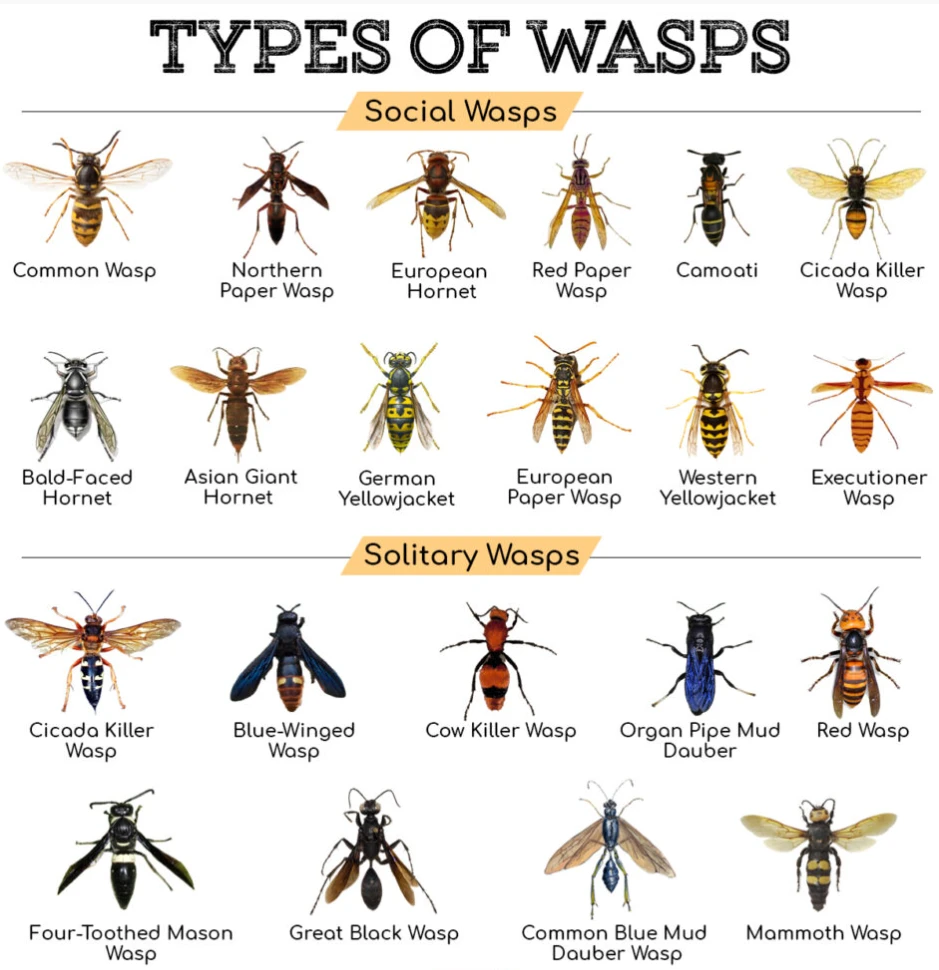
Introduction to Wasps
Wasps, an intriguing and often misunderstood group of insects, are a vital part of our ecosystems. Belonging to the order Hymenoptera, they share this classification with bees and ants. These insects are not only diverse but also exhibit complex behaviours and interactions within their habitats. Understanding wasps helps appreciate their ecological roles and the benefits they offer, despite their sometimes fearsome reputation.
Physical Characteristics of Wasps
Wasps exhibit a variety of physical characteristics that make them distinct and identifiable. From their size and shape to their coloration and flight capabilities, these features are adapted to their diverse lifestyles.
Size and Shape
Wasps vary greatly in size, ranging from tiny species that are only a few millimetres long to large ones exceeding 3 centimetres. They typically have a slender, elongated body with a narrow waist (petiole) that separates the thorax and abdomen. This characteristic shape is not only aerodynamic but also facilitates their predatory and foraging activities.
Coloration
Many wasps exhibit bright warning colours, such as yellow and black stripes, though they can also be metallic blue, green, or red. Their coloration often serves as a deterrent to predators. The vivid patterns and colours signal potential danger to predators, thanks to their ability to sting.
Wings and Flight
Wasps possess two pairs of wings, with the forewings being larger than the hindwings. Their flight is generally fast and agile, aiding in both hunting and evasion from threats. This capability allows wasps to cover large areas in search of food or suitable nesting sites, contributing to their success in various environments.
Stingers
Female wasps have a modified ovipositor that serves as a stinger, capable of delivering venom. Unlike bees, many wasp species can sting multiple times. This defence mechanism is crucial for protecting themselves and their nests from predators and intruders.
Classification and Species of Wasps
Social Wasps
These include species like yellowjackets and hornets, live in colonies with a division of labour. Colonies consist of a queen, workers, and males. The Social wasp will build nests from paper-like materials made by chewing wood fibres mixed with saliva. Their cooperative behaviour allows them to efficiently manage resources, defend their nests, and care for their young.
Solitary Wasps
A Solitary wasp will not form a colony. Each female independently builds and provisions her own nest. This group includes the mud daubers, potter, and sand wasps. Despite their solitary nature, they play critical roles in ecosystems by controlling pest populations and pollinating plants.
Life Cycle of Wasps
The life cycle of a wasp typically follows complete metamorphosis, consisting of four stages: egg, larva, pupa, and adult.
Egg
The queen or solitary female lays eggs in a suitable location, such as within a nest or in a paralyzed prey. This initial stage is crucial for the continuation of the species, as the placement and protection of eggs determine the survival of the next generation.
Larva
After hatching, the larvae are fed by the queen or worker wasps (in social species) or consume the paralyzed prey provided by their mother (in solitary species). Larvae are typically voracious feeders, requiring a steady supply of protein to grow and develop.
Pupa
Larvae spin a cocoon and undergo pupation, transforming into adult wasps. This transformative stage is where the larva changes into its adult form, ready to emerge and fulfil its ecological role.
Adult
Adults emerge from the pupal stage, ready to continue the cycle. They engage in various activities such as foraging for food, mating, and in the case of social wasps, maintaining the colony structure.
Behaviour of Wasps
Wasps exhibit a range of behaviours that are crucial for their survival and ecological success. These behaviours include social structure, feeding habits, and interactions with other species.
Social Structure
In social species, the colony functions with a strict hierarchy. The queen is responsible for laying eggs, while workers maintain the nest, care for the young, and forage for food. Males typically only emerge to mate and then die shortly after. This division of labour ensures the efficient functioning of the colony and the survival of the species.
Feeding
Many adults feed on nectar and other sugary substances, while larvae are often fed protein-rich foods like insects or carrion. This dietary flexibility allows wasps to exploit a variety of food sources, contributing to their adaptability.
Predation and Parasitism
Wasps play critical roles as predators and parasiticides. They control pest populations by hunting insects or laying their eggs in or on other insects, which are eventually consumed by the developing larvae. This predatory behaviour helps maintain ecological balance by regulating the populations of other insect species.
Ecological Impact
Wasps have significant ecological impacts, contributing to various ecosystem functions and services.
Pollination
While not as efficient as bees, many wasps contribute to pollination as they forage for nectar. Their role in pollination supports plant reproduction and the production of fruits and seeds, benefiting both natural and agricultural systems.
Pest Control
By preying on a wide variety of insects, wasps help regulate pest populations, benefiting agricultural and garden ecosystems. Their predatory activities reduce the need for chemical pesticides, promoting more sustainable pest management practices.
Biodiversity Indicators
The presence and diversity of wasp species in an area can indicate the health of an ecosystem. A rich and diverse wasp population often reflects a balanced and thriving environment.
Conservation of Wasps
Despite their sometimes negative reputation, wasps are an essential part of many ecosystems. Conservation efforts focus on habitat preservation and understanding their ecological roles to maintain biodiversity and ecological balance. Protecting wasp habitats and promoting awareness of their benefits can help ensure their continued contribution to ecosystem health.
Conclusion
In summary, wasps are diverse and vital insects with complex behaviours and significant ecological roles. Their interactions with the environment and humans reflect their importance in maintaining ecological health and balance. Understanding and appreciating wasps can help foster coexistence and support conservation efforts.

Leave a Reply